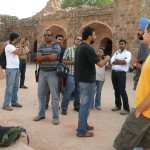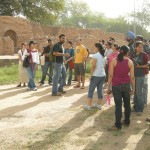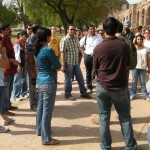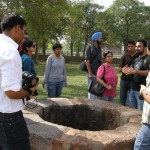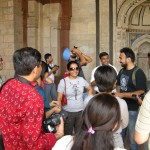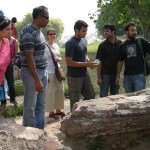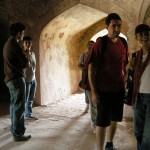Heritage walk to Purana Qila & its neighbourhood, 28 Mar 2010
- Khair ul manazil
- ruins of shops near Lal darwaza
- near Talaqui darwaza
- well with inscription
- Sher Shah’s mosque
- at Sher Mandal, Humayun’s library
- hammam
- inside Humayun darwaza
- with Humayun darwaza in backdrop
This month’s special was the heritage walk to Purana Qila (old Fort), led by Anand Taneja. We began the walk from Khair ul Manazil, the Mughal-period madrasa which stands right opposite the Purana Qila. Delhi generally is not associated with Akbar’s reign, but there do exist some monuments associated with him. Khair ul Manazil is a madrasa built by Akbar’s wet nurse, Maham Anga. Adjacent to it are remains of gates & fortifications of Sher Shah’s city. There is a row of single-room structures leading up to the Lal Darwaza, one of the gates of Sher Shah’s capital. These rooms have been identified as shops. Entry to the Old Fort is from near the Delhi zoo. There is a lot of conservation work being done around the gates of the fort so some parts of it are inaccessible. The Old Fort is traditionally associated with the site of Indraprastha, the legendary capital of the Pandavas in Mahabharata and then with Sher Shah Sur and Humayun. The most prominent monuments inside the Old Fort are the Qila i- Kunha mosque and the Sher Mandal. The latter is traditionally believed to have been used by Humayun as his library and the very place where he met his death by falling down the stairs. Close to it is a hammam, which is a late-Mughal period addition. We can still see the terracotta pipes which were used to supply water to it. The source of water could have been the baoli (step well) which is nearby. Walking towards the Humayun darwaza, we come across the area which looks like a ditch cut by a stream of water. This is where the archaeological excavations were carried out. Its findings are displayed in an archaeological museum in the Purana Qila complex but it was closed for repair. There is much more history to Purana Qila than is evident from its monuments. Till the second decade of 20th century, there existed a village by the name of Indrapat within the fort walls built very close to the monuments we can now see. It was cleared by the British, who undertook organized conservation activity here. Again, immediately after partition of the subcontinent in 1947, this fort became a huge refugee camp. Of course there is no trace of it left now except for ASI offices which were used as school buildings when refugees lived here.
(posted by Kanika Singh, team member, Delhi Heritage Walks)
